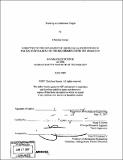Tracking an underwater target
Author(s)
Gomez, Christina, S.B. Massachusetts Institute of Technology
DownloadFull printable version (1.275Mb)
Other Contributors
Massachusetts Institute of Technology. Dept. of Mechanical Engineering.
Advisor
Franz S. Hover.
Terms of use
Metadata
Show full item recordAbstract
Autonomous underwater vehicles are becoming an important part in marine research. In order to help bring down the cost of running a research mission with an autonomous underwater vehicle (AUV), the method of tracking the AUV can be improved. An autonomous surface vessel (ASV), equipped with both acoustic instrumentation and wireless or radio communication technology, can successfully track the AUV and interface with scientists. An ASV named RoBoat, built at MIT in undergraduate classes using a kayak hull, is vessel that can be controlled remotely. To help RoBoat become fully autonomous, a program must be created to take in the data from the underwater acoustic sensors and output commands that the kayak can follow. This thesis studies the homing rules that govern the kayak, under realistic tracking scenarios. The kayak dynamics were modeled and the response to several AUV paths was simulated. The simulation uses many of the kayak properties to be able to create a model that can be used with this specific ASV. The AUV is modeled as a single point target and follows four different common trajectories: a straight line, a line with a delayed start, a simple turn and a lawnmower configuration. (cont.) There were several quantities varied throughout these four cases in order to understand more about the nature of the model; these quantities are the speed of the vehicles, the thrust control gain, the heading control gains and in the lawnmower case the distance between a turn around. With this controller, the kayak responded in predictable ways. An decrease in speed and an increase in the thrust control gain will both lead to smaller trailing distance. Both quantities had large effects on the response and path of the kayak. The heading control gains had very little effect in any of the situations. When the kayak encounters sharp turns, it can overshoot the target path, but will settle within fifty seconds. Within these scenarios encountered, the kayak did not fail its mission; the kayak always stabilizes to a reasonable path.
Description
Thesis (S.B.)--Massachusetts Institute of Technology, Dept. of Mechanical Engineering, 2007.
Date issued
2007Department
Massachusetts Institute of Technology. Department of Mechanical EngineeringPublisher
Massachusetts Institute of Technology
Keywords
Mechanical Engineering.